Fouga CM.170 & 170R
Magister
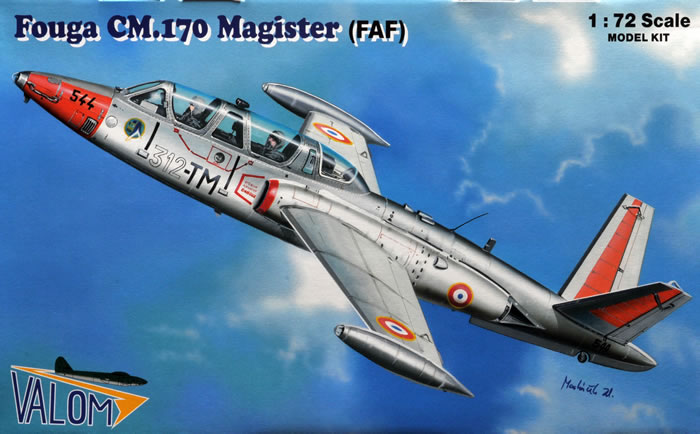
Valom, 1/72 scale
S u m m a r y : |
Catalogue Number: |
Valom Kit Nos.
72083 Fouga CM.170 Magister (FAF)
72084 Fouga CM.170R Magister (Luftwaffe) |
Scale: |
1/72 |
Contents & Media: |
Each kit has 46 tan and 9 clear styrene parts, 28 resin parts (includes almost 50% spares), plus a PE fret of 60 parts, with decals for two subjects. |
Price: |
Available on-line from these stockists: |
72083 (FAF) |
Hannants for £16.66 |
Modelimex for €14.58 |
Westcoast Hobbys for Can$33.00 |
72084 Luftwaffe) |
Hannants for £16.66 |
Modelimex for €14.58 |
Westcoast Hobbys for Can$33.00 |
(Click here for currency conversion) |
Review Type: |
First Look. |
Advantages: |
Very good quality multi-media kit, excellent levels of detail and scale finesse. The best 1/72 Magister kits I have seen so far. |
Disadvantages: |
The smallest detail parts I have ever encountered in writing over 400 reviews and owning 2,500 1/72-scale kits, so small in fact that many will choose to ignore them - In which case they basically cease to be a disadvantage! |
Conclusion: |
This is Valom’s best-produced kit I have seen to date. The crispness and finesse is the equal of the best limited-run kits from other leading Czech brands.
Valom’s detail levels completely surpass those of Heller’s and Airfix’s 1980’s offerings in all areas. Whilst this holds true for the styrene parts, some of the price of this superior detail is the added complexity of using PE and resin parts. I am happy with this trade-off, but Valom may have pushed the envelope too far by using incredibly small air scoops that are but a fraction of a millimetre-cubed in size, and frankly so small, many modellers will ignore using them.
Valom’s new-tool Magister is without doubt the best kit of this attractive subject in 1/72 scale so far released. It is soon to be rivalled by a new release from Special Hobby that appears to be extremely good too, based on pre-release images. We shall have to see if it is equalled or bettered. Regardless of whether it is or not, I highly recommend Valom’s new Magister kits. |
Reviewed by
Mark Davies

HyperScale is proudly supported by Squadron.com
The Fouga Magister (company designation CM.170) is a 1950s French two-seat jet trainer. The related CM.175 Zephyr was a carrier-capable version for the French Navy.
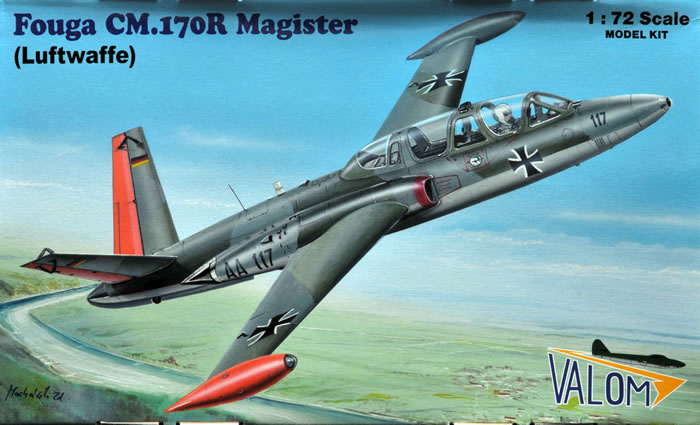
Although it is sometimes lauded as the first purpose-built two-seat turbojet-powered trainer aircraft, similar claims are made for the Fokker S.14 Machtrainer whose first flight, production and service entry were all about a year earlier. However, the Magister was much more successful than the Machtrainer, being produced in far greater numbers and being exported to many nations. Nearly 1,000 Magisters were constructed compared to the 21 Machtrainers.
Source: Wikepedia
Previous 1/72 Scale Magister Kits
I am only aware of two previous Magister kits in The One True Scale, but fortunately both have been good ones, these being by Heller and Airfix. They are not a common tooling despite some mould sharing by these brands when owned by Humbrol. They date from 1980 and 1981 respectively, and are produced to a very similar standard. They both have very fine and restrained raised surface detail, with good cockpit detail for their time. I have built both, and rate the Heller kit as being the slightly better of the two. As to the Zephyr naval version, I am only aware of a conversion offered by Modelart. This was a comprehensive resin set that included a new fuselage and dates from late-1998.
Despite both being good kits, the Heller and Airfix kits still leave room in the market for a more modern and improved kit. At around the same time that Valom’s kits hit the shelves Special Hobby also announced new 1/72-scale Magister and Zephyr kits. I have yet to get one of these, but the images suggest that their appearance is very similar indeed to Valom’s new kit, even down to the colour of plastic used. So it seems, ironically enough, that once again, we will have the choice of two very similar standard Magister kits (not to mention a Zephyr at last). For now, I shall focus on Valom’s new offering, which is most welcome.
Contents
Markings aside, the two kits reviewed here have identical contents and instructions, so I shall use the singular, kit, throughout. Valom have also announced Israeli, Belgian, and Irish & Finish air force boxings of this kit, but I have not seen these, or read any reviews of them as yet.
The kit comes in Valom’s standard and adequately sturdy top-opening box with attractive artwork that leaves no doubt about the Magister’s somewhat unusual lines. The contents are sealed in a cellophane bag, with the clear parts, resin parts, PE and decals further sensibly protected in their own little bags.
The instructions are again to Valom’s usual standard, printed on glossy paper and folded to form a booklet. They provide an aircraft history in both Czech and English and include a parts map. The assembly diagrams are clear to follow with just occasional instructions in Czech and English as needed. The painting and decaling guide is in colour, and a stand-out feature of Valom kits is their cross-referencing of colours to FS 595B, and the paint ranges of Humbrol, Agama, Model Master and Gunze Sangyo.
The Kit
I was immediately struck by the different appearance of the sprues from Valom’s usual limited-run grey items. This kit's parts look very similar in style to those of AZ Model’s new HQ metal-mould kits. I know that AZ Model uses a third party producer for their new HQ kits; could it be Valom has done the same?
Regardless of who makes them, the parts are in tan plastic with very crisp and clean moulding. Surface detail is very finely engraved, and there are numerous extremely fine parts that appear as good as from any brand in this scale. I am pleased to report that Valom has dropped representing every rivet line; a questionable feature of some their more recent releases. There is also a well-produced PE fret and some crisply cast resin detail parts; but more on these later.
The kit follows a conventional parts breakdown for the subject. I think that the parts fit should be very good, although there is no way to be sure without building.
The cockpit is very well detailed, using a combination of styrene, resin and PE. In styrene are the main tub and consoles; cockpit sidewall detail (moulded integrally with the fuselage halves); very fine control columns; seat and rear instrument panel support frames; and the rear faces of the instrument panels, which even feature rear-protruding instrument casings. PE provides for the seat harnesses, rudder pedals, and instrument panels. These last items are backed by instrument films. Resin caters for the seats and extremely delicate throttles. The instructions are very thorough regarding colour call-outs for this stage of construction.
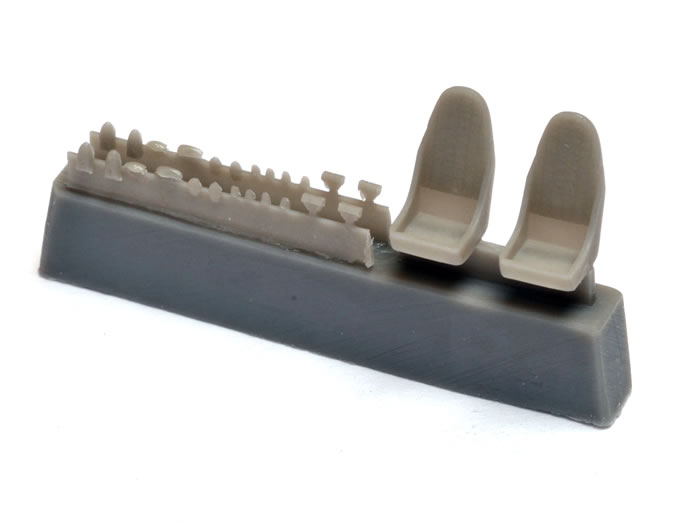
There is a choice of closed or open canopies, the latter being more than justified given the quality of cockpit detail. The transparent parts are very clear, and whilst quite acceptable, are perhaps just a smidgen thicker than I would have hoped for. There are also two styrene pieces to provide for the external and internal parts of the instructor’s periscope. The instructions include a detail sketch of the open canopies, each with hinged bracing struts to hold them open; but the kit does not provide these, which is surprising given some of the levels of detail provided.
Before enclosing the cockpit sub-assembly within the fuselage there is a nose wheel-well, rear cockpit decking detail, two engine compressor faces and exhaust nozzles to fit. The intakes and their splitter plates fit to the outside. I suggest adding ballast where possible, but space is very limited, although the front portions of the wingtip-tanks can be used too. I know that I found enough room in both of my Heller and Airfix Magisters to avoid tail-sitting, so I assume the same will apply to Valom’s kit.
The wing halves enclose separate and well detailed main wheel-wells. The instructions advise that 0.25-mm needs to be filed off their inside faces to enable a satisfactory fit within the wing. Not everyone will like the butt-fit of the wings to the protruding wing-roots, but I think it will be fine. The canted butterfly tail surfaces have small locating lugs however.
The undercarriage is especially nicely done, with some very fine moulding and nice detail. The wheels, legs, main doors, and retraction struts are in styrene; whilst PE is used for the main-leg torque-links, undercarriage door hinges, and the nose-wheel door (which is in two parts). There is also a tiny styrene tail-bumper wheel. The instructions include detail-sketches of the real undercarriage that show where to add brake-lines if the builder wishes.
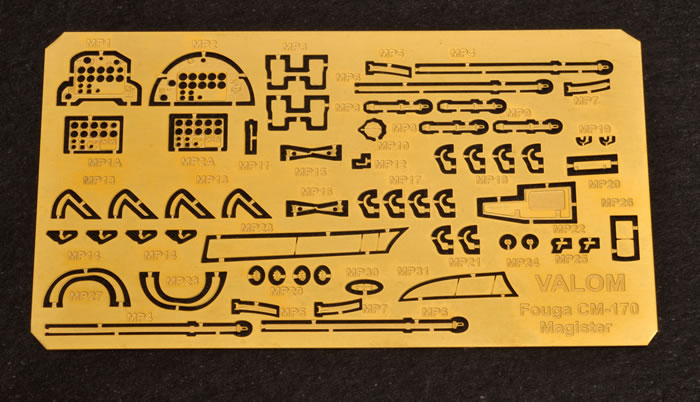
PE caters for the various flying control surface actuators, the rear under-fuselage strakes, a blade antenna, and two tiny pitots ahead of the windscreen. It also provides the two nose-mounted curved ground handling handles applicable to the French version; however, the common instructions indicate to drill holes to accept these but then fail to mention the PE parts! The clear parts also include wingtip-tank and nose lights.
Now I come to the most contentious aspect of this kit in my opinion. The Magister has a number of small scoops around the rear engine casings. Valom has chosen to provide these as separate items; styrene is used for the larger ones, and resin for the smaller scoops. This has the benefit of enabling the open mouths of the larger scoops to be included. However, even the largest styrene scoops are still tiny, around 1.5-mm cubed, whilst the resin scoops are all minute; some, without exaggeration, are about the size of a couple of grains of white sugar! They will have to be picked up with a moistened size-000 paintbrush, if it indeed proves possible to remove them from the casting block without permanent loss.
Valom thoughtfully provides a spare set of all the resin scoops, but less helpfully refers to a resin-scoop part #6 in the instructions, whilst only listing up to #5 in the parts map! I really think that the vast majority of modellers would have preferred to see these tiny scoops moulded integrally with the fuselage. The resin parts could still be included for those who earn a living as neuro-surgeons, should they wish to use them. To be honest, these resin parts are so tiny that many will, I think, choose to just ignore them. They are without doubt the smallest kit components I have ever encountered after writing over 400 reviews and owning 2,500 or so different 1/72-scale kits.
I do not wish to end my discussion of the kit parts with what may seem a sour note; although I am more incredulous than dismayed regarding the “nano-scoops”. Ninety-nine percent of this kit appears to be of excellent quality (if we ignore a couple of loose-ends in the instructions). Resin scoops aside, a small degree of limited-run assembly skill may still be needed; but this is a finely manufactured kit, and by far the most refined offering from Valom I have seen (and I have nearly all of them).
Marking Options
The decals appear to good opacity and are well registered. I recently used some Valom decals and found them to be thin and very good to use, but very fragile to shift if you made an error after tamping them down. A reasonable quantity of stencilling is provided with both kits, and the French boxing includes Day-Glo panels which is handy.
he markings offered in each case are:
72083 CM.170 (FAF):
-
Training & Operational Unit, G.E.312, BA 701, Salon de Provence, and
-
Training & Operational Unit, G.E.315, BA 709, Salon de Provence.
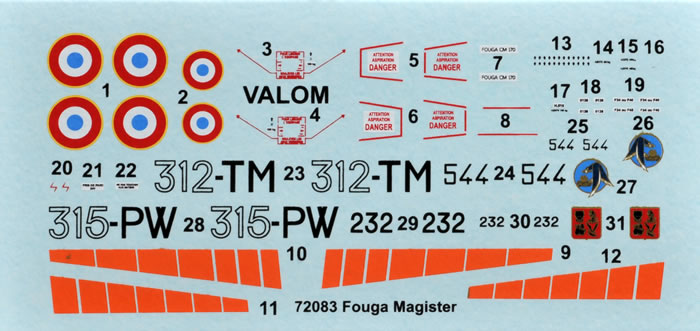
72084 CM.170R (Luftwaffe):
-
AA-117, FFS “A” / Flugzeugfureschule A, 1966, and
-
AA-193, WASlw, Erding, 1960.

(For more choices, see my recent “First Look” at Max Decals’ International Fouga Magister Selection here on HyperScale.)
This is the best-produced kit I have seen from Valom to date. The quality of moulding suggests at least a metal-coated tool, if not a full metal machined one. The crispness and finesse is the equal of the best limited-run kits from other leading Czech brands, and looks very similar to the third-party tooling used by AZ Models for their recent QH (High Quality) releases
Valom’s detail levels completely surpass those of Heller’s and Airfix’s 1980’s offerings in all areas. Whilst this holds true for the styrene parts, some of the price of this superior detail is the added complexity of using PE and resin parts. I am happy with this trade-off, but the relative simplicity of the still nice 1980’s kits may suffice for those who just want to model various colour schemes. In fact, Valom may have pushed the envelope too far by using incredibly small air scoops that are but a fraction of a millimetre-cubed in size, and frankly so small, many modellers will ignore using them. I feel that this detail should have been moulded integrally with the styrene fuselage halves, and leave modellers the option of removing them to replace with resin “nano-scoops” supplied.
Valom’s new-tool Magister is without doubt the best kit of this attractive subject in 1/72 scale so far released. It is soon to be rivalled by a new release from Special Hobby that appears to be extremely good too, based on pre-release images. We shall have to see if it is equalled or bettered. Regardless of whether it is or not, I highly recommend Valom’s new Magister kits.
Thanks to Valom for the review sample.
Review Text Copyright © 2014 by Mark Davies
Review Images Copyright © 2014 by Brett Green
Page Created 5 March, 2014
Last updated
6 March, 2014
Back to HyperScale Main Page

|
